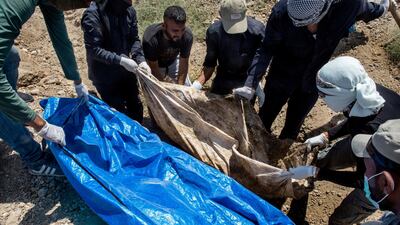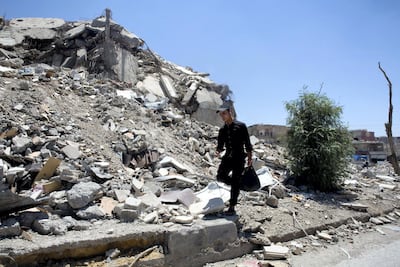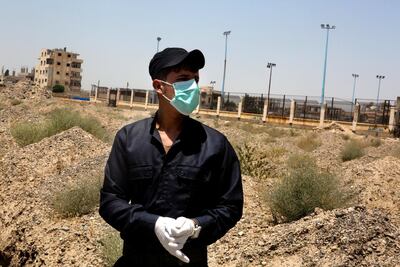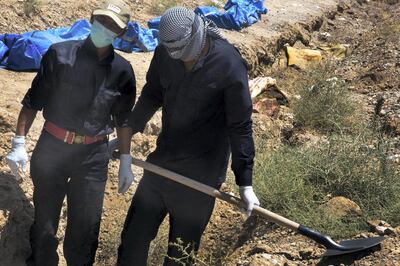Nine months after the liberation of Raqqa from ISIS, the northern Syrian city lies in a heap of debris. Some buildings are crumpled in on themselves, punctured by protruding metal beams and drooping electric wiring, others are just skeletons of what were once people's homes. On the dusty streets, the burnt carcasses of cars and chunks of plaster are strewn everywhere.
Raqqa fell to ISIS in January 2014, becoming the group's de-facto capital. For more than three years the city was ruled by Abu Bakr Al Baghdadi's men. In October 2017, following a four-month siege, Raqqa was recaptured by a coalition of Kurdish-led Syrian Democratic Forces and US air power. The city, once home to 200,000 was largely flattened.
But the endless mounds of rubble that mark the landscape are not the only legacy of the war. An acrid smell of dead bodies lingers in the air.
There are no official figures, but some estimates put the number of civilians killed during the retaking of Raqqa at 1,873 at least.
“Most of the bodies are still under the rubble”, said Zaid Hammdi, the owner of an ice-cream shop in front of Naim square, where ISIS militants carried out public executions and crucifixions.
Not far from his shop, under the scorching midday sun, a group of fatigued men wearing mouth masks, blue overalls and gloves shovel through the rubble. Ditches pepper the ground around them.
They are members of Raqqa's Civil Defence Unit, a team of 105 firefighters and other first aid responders, tasked with recovering bodies.
Closer to the excavation site, the smell of death grows pungent.
“This is a young boy, aged around 35-years-old”, says Assad Mohammed, an elderly medical examiner, inspecting the body's teeth. “He probably died inside a hospital since he is wrapped in a sheet,” Dr Mohammed tells his assistant, who scribbles the details in a notebook.
__________
Read more:
Editorial: The UAE's pledge of $50 million to rebuild Raqqa should encourage other donors to step forward
Coalition attacks on Syria's Raqqa may have broken law, Amnesty says
__________
For six months now members of the Civil Defence Unit have worked day in and day out to uncover mass graves and makeshift cemeteries.
In June Raqqa's First Responders Team - part of the Civil Defence Unit - uncovered a mass grave containing 553 bodies in the city's Al Rashid local playground. They have since begun exhuming a second grave.
Human Rights Watch say there are at least nine mass graves in Raqqa, each one with an estimated dozens, if not hundreds, of bodies. This, said HRW Priyanka Motaparthy makes exhumations a monumental task.
“I became the friend of death,” says Dr Mohammed. “Most of the bodies we found [inside the grave] have been buried quickly by their relatives or acquaintance during the fighting. They’re not people killed by ISIS.”
According to Turkey Ali, the administrative supervisor of the Civil Defense Unit, most deaths were a result of air strikes. “We have found up to 70 bodies a day under a bombed building. We have extracted burned corpses, parts of bodies. We have recovered around 1,200 bodies under the rubble but most of them are not identified."
This is carried out without DNA identification technology, Mr Ali told The National.
“We look at their bones and teeth to discover their gender and age and their clothes. We write everything in a file, the quality of clothes, the neighbourhood where we find the bodies and if they have any objects with them. Each one has its own file and we save all the information" says Mr Ali.
According to a HRW report the lack of technical assistance could damage and destroy evidence crucial to future justice efforts and may not provide families with the answers they have been waiting for.
As Mr Ali and his team dig up the ground in Zoo Park, in Raqqa's Al Furat neighbourhod, a man in a red keffiyeh asks after his relatives: "my cousin and uncles were captured by Daesh in 2014. Where are their bodies? Do you have any information?"
"We didn't find any ISIS mass graves inside Raqqa city," Mr Ali tells him. "Bodies were probably dumped outside the city or thrown in the river,” he says in reference to civilians killed by ISIS.
According to the Syrian Observatory for Human Rights, ISIS detained over 7,000 Syrians between 2013 and 2017. But after a long military campaign that left thousands dead, hundreds of thousands displaced and most of the city reduced to rubble, many ISIS detainees are still missing.
Patchy information has driven desperate families to search for their loved ones through social media. In late 2017, family members of the disappeared launched a Facebook campaign called Where are the kidnapped by ISIS? in an effort to mobilise the US-led coalition to help them find their friends and family.
“Many people came to us asking for information about their relatives detained or kidnapped by ISIS. Until now we didn’t find any evidence. We are few and we are doing our best. We need some international support,” said Mr Ali.
Not far from the site, a sandstorm approaches. Two young men wander over to the ditches. One gestures to Mr Ali: "we buried our father here during the siege. Can you help us to find his body?"
The%20Roundup%20%3A%20No%20Way%20Out
%3Cp%3E%3Cstrong%3EDirector%3A%3C%2Fstrong%3E%20Lee%20Sang-yong%3Cbr%3E%3Cstrong%3EStars%3A%3C%2Fstrong%3E%20Don%20Lee%2C%20Lee%20Jun-hyuk%2C%20Munetaka%20Aoki%3Cbr%3E%3Cstrong%3ERating%3A%20%3C%2Fstrong%3E3%2F5%3Cbr%3E%3Cbr%3E%3C%2Fp%3E%0A
Muslim Council of Elders condemns terrorism on religious sites
The Muslim Council of Elders has strongly condemned the criminal attacks on religious sites in Britain.
It firmly rejected “acts of terrorism, which constitute a flagrant violation of the sanctity of houses of worship”.
“Attacking places of worship is a form of terrorism and extremism that threatens peace and stability within societies,” it said.
The council also warned against the rise of hate speech, racism, extremism and Islamophobia. It urged the international community to join efforts to promote tolerance and peaceful coexistence.
Real estate tokenisation project
Dubai launched the pilot phase of its real estate tokenisation project last month.
The initiative focuses on converting real estate assets into digital tokens recorded on blockchain technology and helps in streamlining the process of buying, selling and investing, the Dubai Land Department said.
Dubai’s real estate tokenisation market is projected to reach Dh60 billion ($16.33 billion) by 2033, representing 7 per cent of the emirate’s total property transactions, according to the DLD.
A Dog's Journey
Directed by: Gail Mancuso
Starring: Dennis Quaid, Josh Gad, Marg Helgenberger, Betty Gilpin, Kathryn Prescott
3 out of 5 stars
RESULTS
5pm: Maiden (PA) Dh80,000 1,400m, Winner SS Lamea, Saif Al Balushi (jockey), Ibrahim Al Hadhrami (trainer).
5.30pm: Wathba Stallions Cup Handicap (PA) Dh70,000 1,400m, Winner AF Makerah, Sean Kirrane, Ernst Oertel
6pm: Handicap (PA) Dh80,000 1,600m, Winner Maaly Al Reef, Brett Doyle, Abdallah Al Hammadi
6.30pm: Handicap (PA) Dh90,000 1,600m, Winner AF Momtaz, Antonio Fresu, Musabah Al Muhairi
7pm: Handicap (PA) Dh80,000 2,200m, Winner Morjanah Al Reef, Brett Doyle, Abdallah Al Hammadi
7.30pm: Handicap (TB) Dh100,000 2,200m, Winner Mudarrab, Jim Crowley, Erwan Charpy
MATCH INFO
Uefa Champions League, last-16. first leg
Atletico Madrid v Juventus, midnight (Thursday), BeIN Sports
Quick pearls of wisdom
Focus on gratitude: And do so deeply, he says. “Think of one to three things a day that you’re grateful for. It needs to be specific, too, don’t just say ‘air.’ Really think about it. If you’re grateful for, say, what your parents have done for you, that will motivate you to do more for the world.”
Know how to fight: Shetty married his wife, Radhi, three years ago (he met her in a meditation class before he went off and became a monk). He says they’ve had to learn to respect each other’s “fighting styles” – he’s a talk it-out-immediately person, while she needs space to think. “When you’re having an argument, remember, it’s not you against each other. It’s both of you against the problem. When you win, they lose. If you’re on a team you have to win together.”
Groom and Two Brides
Director: Elie Semaan
Starring: Abdullah Boushehri, Laila Abdallah, Lulwa Almulla
Rating: 3/5
Our family matters legal consultant
Name: Hassan Mohsen Elhais
Position: legal consultant with Al Rowaad Advocates and Legal Consultants.
The Word for Woman is Wilderness
Abi Andrews, Serpent’s Tail
Red Sparrow
Dir: Francis Lawrence
Starring: Jennifer Lawrence, Joel Egerton, Charlotte Rampling, Jeremy Irons
Three stars
More coverage from the Future Forum
Mica
Director: Ismael Ferroukhi
Stars: Zakaria Inan, Sabrina Ouazani
3 stars
The%20Super%20Mario%20Bros%20Movie
%3Cp%3E%3Cstrong%3EDirectors%3A%3C%2Fstrong%3E%20Aaron%20Horvath%20and%20Michael%20Jelenic%0D%3Cbr%3E%3Cstrong%3EStars%3A%3C%2Fstrong%3E%20Chris%20Pratt%2C%20Anya%20Taylor-Joy%2C%20Charlie%20Day%2C%20Jack%20Black%2C%20Seth%20Rogen%20and%20Keegan-Michael%20Key%0D%3Cbr%3E%3Cstrong%3ERating%3A%3C%2Fstrong%3E%201%2F5%3C%2Fp%3E%0A
MATCH INFO
Uefa Champions League semi-final, first leg
Bayern Munich v Real Madrid
When: April 25, 10.45pm kick-off (UAE)
Where: Allianz Arena, Munich
Live: BeIN Sports HD
Second leg: May 1, Santiago Bernabeu, Madrid
Blackpink World Tour [Born Pink] In Cinemas
Starring: Rose, Jisoo, Jennie, Lisa
Directors: Min Geun, Oh Yoon-Dong
Rating: 3/5
Avatar: Fire and Ash
Director: James Cameron
Starring: Sam Worthington, Sigourney Weaver, Zoe Saldana
Rating: 4.5/5
GIANT REVIEW
Starring: Amir El-Masry, Pierce Brosnan
Director: Athale
Rating: 4/5
Learn more about Qasr Al Hosn
In 2013, The National's History Project went beyond the walls to see what life was like living in Abu Dhabi's fabled fort:
South Africa squad
Faf du Plessis (captain), Hashim Amla, Temba Bavuma, Quinton de Kock (wicketkeeper), Theunis de Bruyn, AB de Villiers, Dean Elgar, Heinrich Klaasen (wicketkeeper), Keshav Maharaj, Aiden Markram, Morne Morkel, Wiaan Mulder, Lungi Ngidi, Vernon Philander and Kagiso Rabada.
COMPANY%20PROFILE
%3Cp%3E%3Cstrong%3ECompany%20name%3A%3C%2Fstrong%3E%20Alaan%3Cbr%3E%3Cstrong%3EStarted%3A%3C%2Fstrong%3E%202021%3Cbr%3E%3Cstrong%3EBased%3A%3C%2Fstrong%3E%20Dubai%3Cbr%3E%3Cstrong%3EFounders%3A%3C%2Fstrong%3E%20Parthi%20Duraisamy%20and%20Karun%20Kurien%3Cbr%3E%3Cstrong%3ESector%3A%3C%2Fstrong%3E%20FinTech%3Cbr%3E%3Cstrong%3EInvestment%20stage%3A%3C%2Fstrong%3E%20%247%20million%20raised%20in%20total%20%E2%80%94%20%242.5%20million%20in%20a%20seed%20round%20and%20%244.5%20million%20in%20a%20pre-series%20A%20round%3Cbr%3E%3Cbr%3E%3C%2Fp%3E%0A
SPEC%20SHEET%3A%20NOTHING%20PHONE%20(2a)
%3Cp%3E%3Cstrong%3EDisplay%3A%3C%2Fstrong%3E%206.7%E2%80%9D%20flexible%20Amoled%2C%202412%20x%201080%2C%20394ppi%2C%20120Hz%2C%20Corning%20Gorilla%20Glass%205%3C%2Fp%3E%0A%3Cp%3E%3Cstrong%3EProcessor%3A%3C%2Fstrong%3E%20MediaTek%20Dimensity%207200%20Pro%2C%204nm%2C%20octa-core%3C%2Fp%3E%0A%3Cp%3E%3Cstrong%3EMemory%3A%3C%2Fstrong%3E%208%2F12GB%3C%2Fp%3E%0A%3Cp%3E%3Cstrong%3ECapacity%3A%3C%2Fstrong%3E%20128%2F256GB%3C%2Fp%3E%0A%3Cp%3E%3Cstrong%3EPlatform%3A%3C%2Fstrong%3E%20Android%2014%2C%20Nothing%20OS%202.5%3C%2Fp%3E%0A%3Cp%3E%3Cstrong%3EMain%20camera%3A%3C%2Fstrong%3E%20Dual%2050MP%20main%2C%20f%2F1.88%20%2B%2050MP%20ultra-wide%2C%20f%2F2.2%3B%20OIS%2C%20EIS%2C%20auto-focus%2C%20ultra%20XDR%2C%20night%20mode%3C%2Fp%3E%0A%3Cp%3E%3Cstrong%3EMain%20camera%20video%3A%3C%2Fstrong%3E%204K%20%40%2030fps%2C%20full-HD%20%40%2060fps%3B%20slo-mo%20full-HD%20at%20120fps%3C%2Fp%3E%0A%3Cp%3E%3Cstrong%3EFront%20camera%3A%3C%2Fstrong%3E%2032MP%20wide%2C%20f%2F2.2%3C%2Fp%3E%0A%3Cp%3E%3Cstrong%3EBattery%3A%3C%2Fstrong%3E%205000mAh%3B%2050%25%20in%2030%20mins%20w%2F%2045w%20charger%3C%2Fp%3E%0A%3Cp%3E%3Cstrong%3EConnectivity%3A%3C%2Fstrong%3E%20Wi-Fi%2C%20Bluetooth%205.3%2C%20NFC%20(Google%20Pay)%3C%2Fp%3E%0A%3Cp%3E%3Cstrong%3EBiometrics%3A%3C%2Fstrong%3E%20Fingerprint%2C%20face%20unlock%3C%2Fp%3E%0A%3Cp%3E%3Cstrong%3EI%2FO%3A%3C%2Fstrong%3E%20USB-C%3C%2Fp%3E%0A%3Cp%3E%3Cstrong%3EDurability%3A%3C%2Fstrong%3E%20IP54%2C%20limited%20protection%20from%20water%2Fdust%3C%2Fp%3E%0A%3Cp%3E%3Cstrong%3ECards%3A%3C%2Fstrong%3E%20Dual-nano%20SIM%3C%2Fp%3E%0A%3Cp%3E%3Cstrong%3EColours%3A%3C%2Fstrong%3E%20Black%2C%20milk%2C%20white%3C%2Fp%3E%0A%3Cp%3E%3Cstrong%3EIn%20the%20box%3A%3C%2Fstrong%3E%20Nothing%20Phone%20(2a)%2C%20USB-C-to-USB-C%20cable%2C%20pre-applied%20screen%20protector%2C%20SIM%20tray%20ejector%20tool%3C%2Fp%3E%0A%3Cp%3E%3Cstrong%3EPrice%20(UAE)%3A%3C%2Fstrong%3E%20Dh1%2C199%20(8GB%2F128GB)%20%2F%20Dh1%2C399%20(12GB%2F256GB)%3C%2Fp%3E%0A
In-demand jobs and monthly salaries
- Technology expert in robotics and automation: Dh20,000 to Dh40,000
- Energy engineer: Dh25,000 to Dh30,000
- Production engineer: Dh30,000 to Dh40,000
- Data-driven supply chain management professional: Dh30,000 to Dh50,000
- HR leader: Dh40,000 to Dh60,000
- Engineering leader: Dh30,000 to Dh55,000
- Project manager: Dh55,000 to Dh65,000
- Senior reservoir engineer: Dh40,000 to Dh55,000
- Senior drilling engineer: Dh38,000 to Dh46,000
- Senior process engineer: Dh28,000 to Dh38,000
- Senior maintenance engineer: Dh22,000 to Dh34,000
- Field engineer: Dh6,500 to Dh7,500
- Field supervisor: Dh9,000 to Dh12,000
- Field operator: Dh5,000 to Dh7,000
ULTRA PROCESSED FOODS
- Carbonated drinks, sweet or savoury packaged snacks, confectionery, mass-produced packaged breads and buns
- margarines and spreads; cookies, biscuits, pastries, cakes, and cake mixes, breakfast cereals, cereal and energy bars;
- energy drinks, milk drinks, fruit yoghurts and fruit drinks, cocoa drinks, meat and chicken extracts and instant sauces
- infant formulas and follow-on milks, health and slimming products such as powdered or fortified meal and dish substitutes,
- many ready-to-heat products including pre-prepared pies and pasta and pizza dishes, poultry and fish nuggets and sticks, sausages, burgers, hot dogs, and other reconstituted meat products, powdered and packaged instant soups, noodles and desserts.
Red flags
- Promises of high, fixed or 'guaranteed' returns.
- Unregulated structured products or complex investments often used to bypass traditional safeguards.
- Lack of clear information, vague language, no access to audited financials.
- Overseas companies targeting investors in other jurisdictions - this can make legal recovery difficult.
- Hard-selling tactics - creating urgency, offering 'exclusive' deals.
Courtesy: Carol Glynn, founder of Conscious Finance Coaching
T20 World Cup Qualifier fixtures
Tuesday, October 29
Qualifier one, 2.10pm – Netherlands v UAE
Qualifier two, 7.30pm – Namibia v Oman
Wednesday, October 30
Qualifier three, 2.10pm – Scotland v loser of qualifier one
Qualifier four, 7.30pm – Hong Kong v loser of qualifier two
Thursday, October 31
Fifth-place playoff, 2.10pm – winner of qualifier three v winner of qualifier four
Friday, November 1
Semi-final one, 2.10pm – Ireland v winner of qualifier one
Semi-final two, 7.30pm – PNG v winner of qualifier two
Saturday, November 2
Third-place playoff, 2.10pm
Final, 7.30pm
The cost of Covid testing around the world
Egypt
Dh514 for citizens; Dh865 for tourists
Information can be found through VFS Global.
Jordan
Dh212
Centres include the Speciality Hospital, which now offers drive-through testing.
Cambodia
Dh478
Travel tests are managed by the Ministry of Health and National Institute of Public Health.
Zanzibar
AED 295
Zanzibar Public Health Emergency Operations Centre, located within the Lumumba Secondary School compound.
Abu Dhabi
Dh85
Abu Dhabi’s Seha has test centres throughout the UAE.
UK
From Dh400
Heathrow Airport now offers drive through and clinic-based testing, starting from Dh400 and up to Dh500 for the PCR test.
UAE currency: the story behind the money in your pockets
Abu Dhabi racecard
5pm: Maiden (Purebred Arabians); Dh80,000; 1,400m.
5.30pm: Maiden (PA); Dh80,00; 1,400m.
6pm: Sheikh Zayed bin Sultan Al Nahyan National Day Cup (PA); Group 3; Dh500,000; 1,600m.
6.30pm: Sheikh Zayed bin Sultan Al Nahyan National Day Cup (Thoroughbred); Listed; Dh380,000; 1,600m
7pm: Wathba Stallions Cup for Private Owners Handicap (PA); Dh70,000; 1,400m.
7.30pm: Handicap (PA); Dh80,000; 1,600m
What is the definition of an SME?
SMEs in the UAE are defined by the number of employees, annual turnover and sector. For example, a “small company” in the services industry has six to 50 employees with a turnover of more than Dh2 million up to Dh20m, while in the manufacturing industry the requirements are 10 to 100 employees with a turnover of more than Dh3m up to Dh50m, according to Dubai SME, an agency of the Department of Economic Development.
A “medium-sized company” can either have staff of 51 to 200 employees or 101 to 250 employees, and a turnover less than or equal to Dh200m or Dh250m, again depending on whether the business is in the trading, manufacturing or services sectors.
BEETLEJUICE BEETLEJUICE
Starring: Winona Ryder, Michael Keaton, Jenny Ortega
Director: Tim Burton
Rating: 3/5
The specs
Engine: 4.0-litre V8 twin-turbocharged and three electric motors
Power: Combined output 920hp
Torque: 730Nm at 4,000-7,000rpm
Transmission: 8-speed dual-clutch automatic
Fuel consumption: 11.2L/100km
On sale: Now, deliveries expected later in 2025
Price: expected to start at Dh1,432,000
Mohammed bin Zayed Majlis
Mobile phone packages comparison
SPECS
%3Cp%3E%3Cstrong%3EEngine%3A%20%3C%2Fstrong%3E2-litre%204-cylinder%20petrol%20(V%20Class)%3B%20electric%20motor%20with%2060kW%20or%2090kW%20powerpack%20(EQV)%0D%3Cbr%3E%3Cstrong%3EPower%3A%3C%2Fstrong%3E%20233hp%20(V%20Class%2C%20best%20option)%3B%20204hp%20(EQV%2C%20best%20option)%0D%3Cbr%3E%3Cstrong%3ETorque%3A%3C%2Fstrong%3E%20350Nm%20(V%20Class%2C%20best%20option)%3B%20TBA%20(EQV)%0D%3Cbr%3E%3Cstrong%3EOn%20sale%3A%20%3C%2Fstrong%3EMid-2024%0D%3Cbr%3E%3Cstrong%3EPrice%3A%20%3C%2Fstrong%3ETBA%0D%3C%2Fp%3E%0A
UK’s AI plan
- AI ambassadors such as MIT economist Simon Johnson, Monzo cofounder Tom Blomfield and Google DeepMind’s Raia Hadsell
- £10bn AI growth zone in South Wales to create 5,000 jobs
- £100m of government support for startups building AI hardware products
- £250m to train new AI models
Company%C2%A0profile
%3Cp%3E%3Cstrong%3ECompany%20name%3A%20%3C%2Fstrong%3ELeap%0D%3Cbr%3E%3Cstrong%3EStarted%3A%20%3C%2Fstrong%3EMarch%202021%0D%3Cbr%3E%3Cstrong%3EFounders%3A%3C%2Fstrong%3E%20Ziad%20Toqan%20and%20Jamil%20Khammu%0D%3Cbr%3E%3Cstrong%3EBased%3A%3C%2Fstrong%3E%20Dubai%0D%3Cbr%3E%3Cstrong%3ESector%3A%20%3C%2Fstrong%3EFinTech%0D%3Cbr%3E%3Cstrong%3EInvestment%20stage%3A%20%3C%2Fstrong%3EPre-seed%0D%3Cbr%3E%3Cstrong%3EFunds%20raised%3A%3C%2Fstrong%3E%20Undisclosed%0D%3Cbr%3E%3Cstrong%3ECurrent%20number%20of%20staff%3A%20%3C%2Fstrong%3ESeven%3C%2Fp%3E%0A
Killing of Qassem Suleimani
SQUADS
UAE
Mohammed Naveed (captain), Mohamed Usman (vice-captain), Ashfaq Ahmed, Chirag Suri, Shaiman Anwar, Mohammed Boota, Ghulam Shabber, Imran Haider, Tahir Mughal, Amir Hayat, Zahoor Khan, Qadeer Ahmed, Fahad Nawaz, Abdul Shakoor, Sultan Ahmed, CP Rizwan
Nepal
Paras Khadka (captain), Gyanendra Malla, Dipendra Singh Airee, Pradeep Airee, Binod Bhandari, Avinash Bohara, Sundeep Jora, Sompal Kami, Karan KC, Rohit Paudel, Sandeep Lamichhane, Lalit Rajbanshi, Basant Regmi, Pawan Sarraf, Bhim Sharki, Aarif Sheikh
Women & Power: A Manifesto
Mary Beard
Profile Books and London Review of Books




